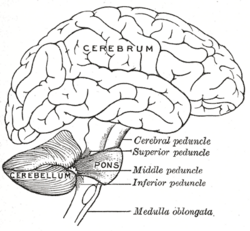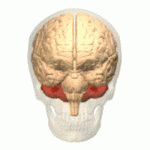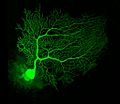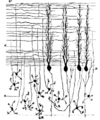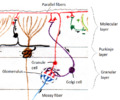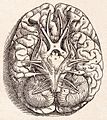Cerebellum facts for kids
| Brain: Cerebellum | ||
|---|---|---|
Quick facts for kids
|
||
| Drawing of the human brain, showing cerebellum and pons | ||
| Location of the human cerebellum (in red) | ||
| Latin | Cerebellum | |
| Part of | Hindbrain | |
| Artery | SCA, AICA, PICA | |
| Vein | superior, inferior | |
The cerebellum (Latin for "little brain") is a major feature of the hindbrain of all vertebrates.
Name
The name cerebellum is a diminutive of the Latin word cerebrum (brain); it can be translated literally as little brain.
Function
In humans, the cerebellum plays an important role in motor control. It may also be involved in some cognitive functions such as attention and language as well as emotional control such as regulating fear and pleasure responses.
The human cerebellum does not initiate movement, but contributes to coordination, precision, and accurate timing: it receives input from sensory systems of the spinal cord and from other parts of the brain, and integrates these inputs to fine-tune motor activity. Cerebellar damage produces disorders in fine movement, equilibrium, posture, and motor learning in humans.
Animals and humans with cerebellar disfunction show problems with motor control on the same side of the body as the damaged part of the cerebellum. They continue to be able to generate motor activity but lose precision, producing erratic, uncoordinated, or incorrectly timed movements.
The cerebellum is generally believed to be involved in pain processing.
Anatomy
The human cerebellum is a separate structure attached to the bottom of the brain, tucked underneath the cerebral hemispheres. The cerebellum consists of a tightly folded layer of cortex (grey matter), with white matter underneath and a fluid-filled ventricle at the base. It is estimated that, if the human cerebellar cortex were completely unfolded, it would look as a layer of neural tissue about 1 meter long and averaging 5 centimeters wide—a total surface area of about 500 square cm, packed within a volume of dimensions 6 cm × 5 cm × 10 cm.
Four deep cerebellar nuclei (clusters of gray matter) lie within the white matter at the core of the cerebellum. They are the sources of output from the cerebellum.
Interesting facts about the cerebellum
- Physicians of Ancient Greece were aware of the cerebellum.
- Galen described it first and speculated that the cerebellum was the source of motor nerves.
- The human cerebellum changes with age.
- The cerebellum is the youngest brain region (and body part) in centenarians: it is about 15 years younger than expected in a centenarian.
- Most vertebrate species have a cerebellum and one or more cerebellum-like structures.
- The list of medical problems that can produce cerebellar damage is long, including stroke, hemorrhage, swelling of the brain (cerebral edema), tumors, alcoholism, physical trauma, and chronic degenerative conditions such as olivopontocerebellar atrophy.
Images for kids
-
Base of the human brain, as drawn by Andreas Vesalius in 1543
See also
 In Spanish: Cerebelo para niños
In Spanish: Cerebelo para niños


